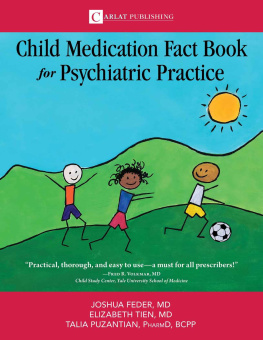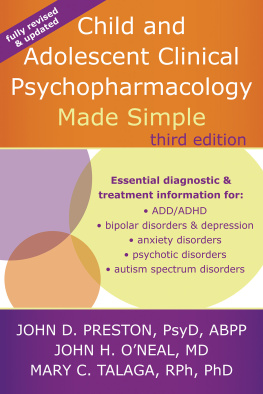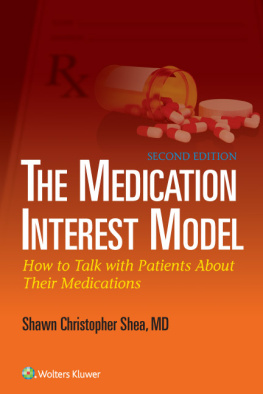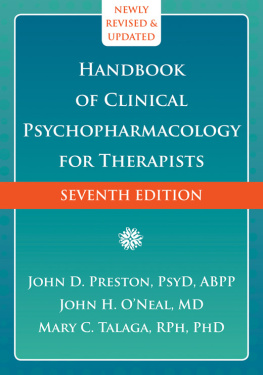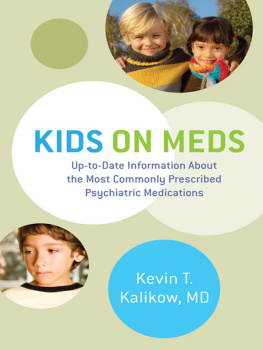
Child Medication Fact Book
For Psychiatric Practice
Published by Carlat Publishing, LLC
PO Box 626, Newburyport, MA 01950
Publisher and Editor-in-Chief: Daniel J. Carlat, MD
Deputy Editor: Talia Puzantian, PharmD, BCPP
Executive Editor: Janice Jutras
All rights reserved. This book is protected by copyright.
This CME/CE activity is intended for psychiatrists, psychiatric nurses, psychologists, and other health care professionals with an interest in mental health. The Carlat CME Institute is accredited by the Accreditation Council for Continuing Medical Education to provide continuing medical education for physicians. Carlat CME Institute is approved by the American Psychological Association to sponsor continuing education for psychologists. Carlat CME Institute maintains responsibility for this program and its content. Carlat CME Institute designates this enduring material educational activity for a maximum of eight (8) AMA PRA Category 1 Credits TM or 8 CE for psychologists. Physicians or psychologists should claim credit commensurate only with the extent of their participation in the activity. The American Board of Psychiatry and Neurology has reviewed the Child Medication Fact Book for Psychiatric Practice and has approved this program as part of a comprehensive Self-Assessment and CME Program, which is mandated by ABMS as a necessary component of maintenance of certification. CME quizzes must be taken online at www.thecarlatreport.com or http://thecarlatcmeinstitute.com/self-assessment (for ABPN SA course subscribers).
To order, visit www.thecarlatreport.com
or call (866) 348-9279
1 2 3 4 5 6 7 8 9 10
ISBN #: 978-0-9975106-9-0
PRINTED IN THE UNITED STATES OF AMERICA
Table of Contents
Note: Some medications, eg guanfacine, are covered in more than one chapter; however, the fact sheets
are listed only in one of those chapters.
Introduction
HOW TO USE THIS BOOK
Medication information is presented in three ways in this book.
Chapter introductions: These are guides to general therapeutic categories of child psychopharmacology. There is natural overlap between these areas; however, we hope that our groupings are convenient for quick reference in everyday office practice.
Medication fact sheets: In-depth prescribing information for select medications (not all psychiatric medications are covered). There are 70 medication fact sheets in this book. Medications that fall into more than one category are included in each applicable chapter table, but each medication has only one fact sheet (placed in the chapter where we believe the medication is most commonly used). We have included most of the commonly prescribed and newer medications for which there are data and experience in children. These fact sheets include dosing, indications and common uses (both on and off label), side effects, mechanisms of action, recommendations for clinical monitoring, evidence, clinical pearls, and fun facts.
Quick-scan medication tables: These are located after the chapter introduction for each therapeutic category and list the very basics: generic and brand names, FDA-approved indications, strengths available, starting doses, and target doses. These tables contain most of the commonly prescribed psychiatric medications in pediatric practice.
CATEGORIES OF MEDICATIONS
We did our best to categorize medications rationally. However, in some cases a medication can fall into more than one category. In such cases, we placed the medications fact sheet in the therapeutic category for which it is most often used. If youre having trouble finding a medication in a particular section, look in the index to find its page number.
MORE ON THE MEDICATION FACT SHEETS
The goal of these fact sheets is to provide need-to-know information that can be easily and quickly absorbed during a busy day of seeing patients. An important goal, therefore, is that all the information should fit on a single page. Please refer to the PDR (Physicians Desk Reference) when you need more in-depth information.
- For the most part, each fact sheet contains the following information:
- Both the brand and generic names.
- Generic availability, denoted with a [G] or (G).
- FDA-approved indications in kids and in adults.
- Off-label uses. We list the more common off-label uses, based on both the medical literature and our own clinical experience. Just because we list a potential use does not imply that we endorse a medication as being particularly effective for that use. We are simply alerting you to the fact that there is some evidence for efficacy or at least reports of use.
- Dosage forms, along with available strengths.
- Dosage guidance. We provide recommendations on how to dose medications; these are derived from a variety of sources, including package inserts, clinical trials, and common clinical practice. In other words, dont be surprised when our dosing instructions are at odds with what you find in the PDR or other sources such as RxList.
- Lab monitoring recommendations. We include the usual routine monitoring measures for each medication. Of course, you may need to think beyond the routine if the clinical picture warrants it.
- Cost information. Pricing information for a 1-month supply of a common dosing regimen was obtained from the website GoodRx ( www.goodrx.com ), accessed in May 2018. These are the prices patients would have to pay if they had no insurance. Because of wide variations in price depending on the pharmacy, in this edition of the Child Medication Fact Book we list price categories rather than the price in dollars. The categories are:
- $: Inexpensive: < $50/month
- $$: Moderate: $50$100/month
- $$$: Expensive: $100$200/month
- $$$$: Very expensive: $200$500/month
- $$$$$: Extremely expensive: > $500/month
Many patients have some type of insurance and are therefore not going to pay retail price, but rather a co-pay, which is usually less expensive. However, off-label uses of medications in child psychiatry are often not covered by insurance. Also, even when covered, the co-pays for medication can be high, particularly for high-deductible insurance plans. With no clear source for accurately predicting a co-pay, you can use the retail price as a clue. Meds that are very inexpensive may require no co-pay, while the most expensive drugs will either require a very expensive co-pay, or, more likely, will not be covered at all without an onerous pre-authorization process.
- Side effects information. We break down side effects into most common vs rare but serious side effects. We generally define most common side effects as those occurring in at least 5% of patients in clinical trials, and which were at least double the rate of the placebo group. Such information is usually found in tables in the drugs package inserts. We also used post-marketing clinical experience as a guide in determining which side effects were common enough to make the list.
- Mechanism of action. While the mechanism of action is not well-established for most psychiatric drugs, we thought it would be important to report the mechanisms most commonly cited.
- Pharmacokinetics, with a focus on drug metabolism and/or half-life.
- Drug interactions.

